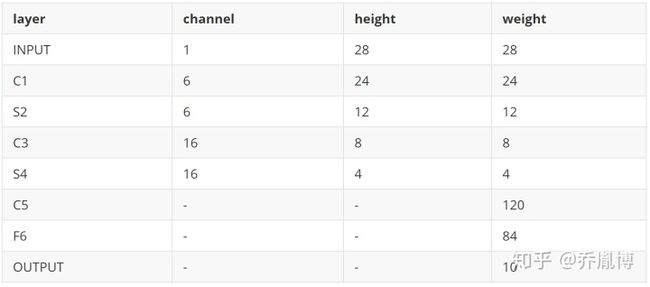pytorch实现手写数字识别_LeNet-5网络实现手写数字识别
LeNet-5是经典CNN(Convolutional Neural Network)神经网络构造之一,第一次是在1995年由 Yann LeCun, Leon Bottou, Yoshua Bengio, 和 Patrick Haffner提出的,这种神经网络结构在MINIST手写数字数据集上取得了优异的结果。下面将与LeNet-5的相关知识介绍一下。
前馈神经网络的限制
当前流行的神经网络主要有三种,前馈神经网络、卷积神经网络和循环神经网络。前馈神经网络是最经典的网络模型,根据通用近似原理,前馈神经网络可以拟合所有的复杂函数,同样也可以用于图像相关的神经网络模型。但是前馈神经网络运用在图像中存在一下几点限制:
- 图像构成的数据,数据维度极大,造成前馈神经网络参数极多,达到数亿级别,虽然计算机计算速度较快,但是面对这种级别的参数学习,仍然力不从心。
- 图像数据输入前馈神经网络时,需要将图片展开为一列,这会导致原本相邻的像素点信息,展开之后距离极远,会导致神经网络对图像的学习不理想,忽略了原本的图像位置关系。
- 图像有些不变特征。比如图像经过放大,缩小,剪切之后,图像大体样貌不变。前馈神经网络处理图像时,这些不变的特性并没有得到很好的利用。
卷积神经网络特点
卷积神经网络可以很好的解决前馈神经网络面对的问题,关键点在于卷积神经网络的独特结构。
卷积神经网络是一种改善的前馈神经网络,也通过反向传播算法进行学习。卷积神经网络的特点是:
- 参数共享(Parameter sharing):一个特征检测器,适用于图片的所有部分。
- 稀疏连接(Sparsity of connections):每层的输出值依赖于输出值的一部分。
LeNet-5
LeNet-5是最早出现的卷积神经网络,推动了卷积神经网络的迅速发展。
LeNet-5包含七层,不包括输入,每一层都包含可训练参数。一个最典型的LeNet-5神经网络模型如下图所示,
模型包含卷积层,池化层和全连接层,上图实例输入图片是32*32像素大小,实际上MINIST图片大小为28*28大小。因此对这个模型做一点点改动。
经过这样的改造,就可以完美适配本次实验的数据集。
MINIST数据集的读取
之前的文章中从零开始实现神经网络--基于MINIST手写数字数据集,有对这个手写数字数据集的介绍,这里和之前有一点点不同,就是测试集的label不需要one-hot形式,而直接采用数字结果即可。
def data_fetch_preprocessing():
train_image = open('train-images.idx3-ubyte', 'rb')
test_image = open('t10k-images.idx3-ubyte', 'rb')
train_label = open('train-labels.idx1-ubyte', 'rb')
test_label = open('t10k-labels.idx1-ubyte', 'rb')
magic, n = struct.unpack('>II',
train_label.read(8))
# 原始数据的标签
y_train_label = np.array(np.fromfile(train_label,
dtype=np.uint8), ndmin=1)
y_train = np.ones((10, 60000)) * 0.01
for i in range(60000):
y_train[y_train_label[i]][i] = 0.99
# 测试数据的标签
magic_t, n_t = struct.unpack('>II',
test_label.read(8))
y_test = np.fromfile(test_label,
dtype=np.uint8).reshape(10000, 1)
# print(y_train[0])
# 训练数据共有60000个
# print(len(labels))
magic, num, rows, cols = struct.unpack('>IIII', train_image.read(16))
x_train = np.fromfile(train_image, dtype=np.uint8).reshape(len(y_train_label), 784)
magic_2, num_2, rows_2, cols_2 = struct.unpack('>IIII', test_image.read(16))
x_test = np.fromfile(test_image, dtype=np.uint8).reshape(len(y_test), 784)
# print(x_train.shape)
# 可以通过这个函数观察图像
# data=x_train[:,0].reshape(28,28)
# plt.imshow(data,cmap='Greys',interpolation=None)
# plt.show()
# 关闭打开的文件
train_image.close()
train_label.close()
test_image.close()
test_label.close()
return x_train, y_train_label, x_test, y_test
建立模型
本次实战采用pytorch构建模型,并进行训练,和更新参数。
class convolution_neural_network(nn.Module):
def __init__(self):
super(convolution_neural_network, self).__init__()
# 定义卷积层
self.conv = nn.Sequential(
nn.Conv2d(in_channels=1, out_channels=6, kernel_size=5, stride=1, padding=0), # 28x28x1-->24x24x6
nn.Sigmoid(),
nn.MaxPool2d(kernel_size=2, stride=2), # 12x12x6
nn.Conv2d(in_channels=6, out_channels=16, kernel_size=5, stride=1, padding=0), # 8x8x16
nn.Sigmoid(),
nn.MaxPool2d(kernel_size=2, stride=2) # 4x4x16
)
# 定义全连接层
self.fc = nn.Sequential(
nn.Linear(in_features=256, out_features=120),
nn.Sigmoid(),
nn.Linear(in_features=120, out_features=84),
nn.Sigmoid(),
nn.Linear(in_features=84, out_features=10),
)
# 前向传播过程
def forward(self, img):
feature = self.conv(img)
output = self.fc(feature.view(img.shape[0], -1))
return output
运行模型
运行模型,采用随机梯度下降的方法来更新参数,实验中设置5轮次的迭代,最终得到超过0.98的正确率。
if __name__ == '__main__':
# 获取数据
x_train, y_train, x_test, y_test = data_fetch_preprocessing()
x_train = x_train.reshape(60000, 1, 28, 28)
# 建立模型实例
LeNet = convolution_neural_network()
# plt.imshow(x_train[2][0], cmap='Greys', interpolation=None)
# plt.show()
# 交叉熵损失函数
loss_function = nn.CrossEntropyLoss()
loss_list = []
optimizer = optim.Adam(params=LeNet.parameters(), lr=0.001)
# epoch = 5
for e in range(5):
precision = 0
for i in range(60000):
prediction = LeNet(torch.tensor(x_train[i]).float().reshape(-1, 1, 28, 28))
# print(prediction)
# print(torch.from_numpy(y_train[i]).reshape(1,-1))
# exit(-1)
if torch.argmax(prediction) == y_train[i]:
precision += 1
loss = loss_function(prediction, torch.tensor([y_train[i]]).long())
optimizer.zero_grad()
loss.backward()
optimizer.step()
loss_list.append(loss)
print('第%d轮迭代,loss=%.3f,准确率:%.3f' % (e, loss_list[-1],precision/60000))
总结
经过实战LeNet-5确实对手写数字数据集有效,并能取得不错的识别结果。
附录 完整代码
#!/usr/bin/env python
# -*- coding:utf-8 -*-
# File: lenet.py
# datetime: 2020/8/7 21:24
# software: PyCharm
import torch.nn as nn
import torch
import torch.optim as optim
import numpy as np
import struct
import matplotlib.pyplot as plt
def data_fetch_preprocessing():
train_image = open('train-images.idx3-ubyte', 'rb')
test_image = open('t10k-images.idx3-ubyte', 'rb')
train_label = open('train-labels.idx1-ubyte', 'rb')
test_label = open('t10k-labels.idx1-ubyte', 'rb')
magic, n = struct.unpack('>II',
train_label.read(8))
# 原始数据的标签
y_train_label = np.array(np.fromfile(train_label,
dtype=np.uint8), ndmin=1)
y_train = np.ones((10, 60000)) * 0.01
for i in range(60000):
y_train[y_train_label[i]][i] = 0.99
# 测试数据的标签
magic_t, n_t = struct.unpack('>II',
test_label.read(8))
y_test = np.fromfile(test_label,
dtype=np.uint8).reshape(10000, 1)
# print(y_train[0])
# 训练数据共有60000个
# print(len(labels))
magic, num, rows, cols = struct.unpack('>IIII', train_image.read(16))
x_train = np.fromfile(train_image, dtype=np.uint8).reshape(len(y_train_label), 784)
magic_2, num_2, rows_2, cols_2 = struct.unpack('>IIII', test_image.read(16))
x_test = np.fromfile(test_image, dtype=np.uint8).reshape(len(y_test), 784)
# print(x_train.shape)
# 可以通过这个函数观察图像
# data=x_train[:,0].reshape(28,28)
# plt.imshow(data,cmap='Greys',interpolation=None)
# plt.show()
# 关闭打开的文件
train_image.close()
train_label.close()
test_image.close()
test_label.close()
return x_train, y_train_label, x_test, y_test
class convolution_neural_network(nn.Module):
def __init__(self):
super(convolution_neural_network, self).__init__()
# 定义卷积层
self.conv = nn.Sequential(
nn.Conv2d(in_channels=1, out_channels=6, kernel_size=5, stride=1, padding=0), # 28x28x1-->24x24x6
nn.Sigmoid(),
nn.MaxPool2d(kernel_size=2, stride=2), # 12x12x6
nn.Conv2d(in_channels=6, out_channels=16, kernel_size=5, stride=1, padding=0), # 8x8x16
nn.Sigmoid(),
nn.MaxPool2d(kernel_size=2, stride=2) # 4x4x16
)
self.fc = nn.Sequential(
nn.Linear(in_features=256, out_features=120),
nn.Sigmoid(),
nn.Linear(in_features=120, out_features=84),
nn.Sigmoid(),
nn.Linear(in_features=84, out_features=10),
)
def forward(self, img):
feature = self.conv(img)
output = self.fc(feature.view(img.shape[0], -1))
return output
if __name__ == '__main__':
# 获取数据
x_train, y_train, x_test, y_test = data_fetch_preprocessing()
x_train = x_train.reshape(60000, 1, 28, 28)
# 建立模型实例
LeNet = convolution_neural_network()
# plt.imshow(x_train[2][0], cmap='Greys', interpolation=None)
# plt.show()
# 交叉熵损失函数
loss_function = nn.CrossEntropyLoss()
loss_list = []
optimizer = optim.Adam(params=LeNet.parameters(), lr=0.001)
# epoch = 5
for e in range(5):
precision = 0
for i in range(60000):
prediction = LeNet(torch.tensor(x_train[i]).float().reshape(-1, 1, 28, 28))
# print(prediction)
# print(torch.from_numpy(y_train[i]).reshape(1,-1))
# exit(-1)
if torch.argmax(prediction) == y_train[i]:
precision += 1
loss = loss_function(prediction, torch.tensor([y_train[i]]).long())
optimizer.zero_grad()
loss.backward()
optimizer.step()
loss_list.append(loss)
print('第%d轮迭代,loss=%.3f,准确率:%.3f' % (e, loss_list[-1],precision/60000))

